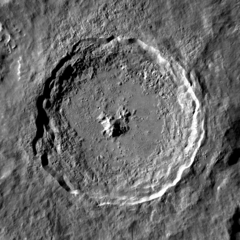Tycho (lunar crater)

Tycho seen by Lunar Reconnaissance Orbiter. NASA
|
|
| Coordinates | 43°19′S 11°22′W / 43.31°S 11.36°WCoordinates: 43°19′S 11°22′W / 43.31°S 11.36°W |
|---|---|
| Diameter | 86 km |
| Depth | 4.8 km |
| Colongitude | 12° at sunrise |
| Eponym | Tycho Brahe |
Tycho (/ˈtaɪkoʊ/) is a prominent lunar impact crater located in the southern lunar highlands, named after the Danish astronomer Tycho Brahe (1546–1601).
To the south of Tycho is the crater Street, to the east is Pictet, and to the north-northeast is Sasserides. The surface around Tycho is replete with craters of various sizes, many overlapping still older craters. Some of the smaller craters are secondary craters formed from larger chunks of ejecta from Tycho.
Tycho is a relatively young crater, with an estimated age of 108 million years (Ma), based on analysis of samples of the crater ray recovered during the Apollo 16 mission. This age suggests that the impactor may have been a member of the Baptistina family of asteroids, but as the composition of the impactor is unknown this is currently conjecture. However, simulation studies give a 70 percent probability that the crater was created by a fragment from the same break-up that created asteroid 298 Baptistina; which was previously believed to be responsible for the formation of Chicxulub Crater and the extinction of the dinosaurs. However, that possibility was potentially ruled out by the Wide-field Infrared Survey Explorer in 2011.
The crater is sharply defined, unlike older craters that have been degraded by subsequent impacts. The interior has a high albedo that is prominent when the Sun is overhead, and the crater is surrounded by a distinctive ray system forming long spokes that reach as long as 1,500 kilometers. Sections of these rays can be observed even when Tycho is illuminated only by earthlight. Due to its prominent rays, Tycho is mapped as part of the Copernican System.
...
Wikipedia
